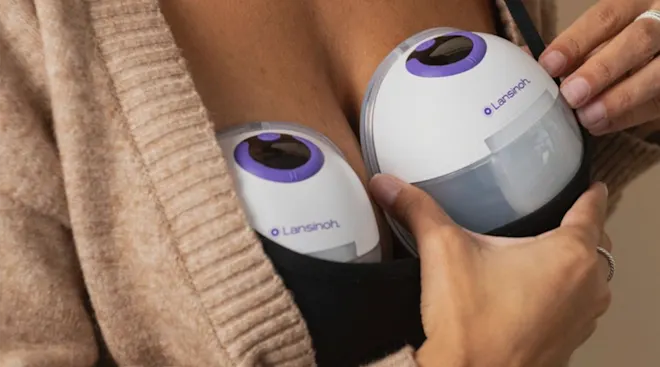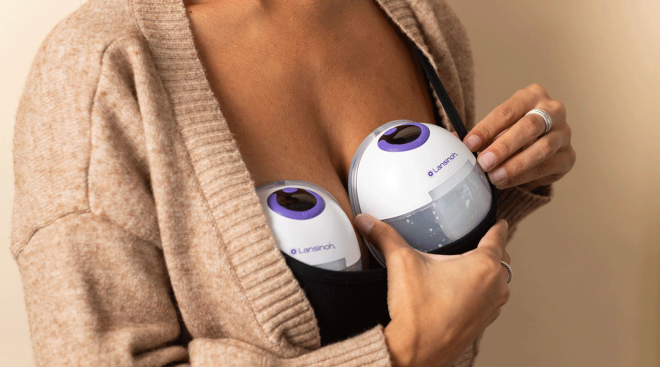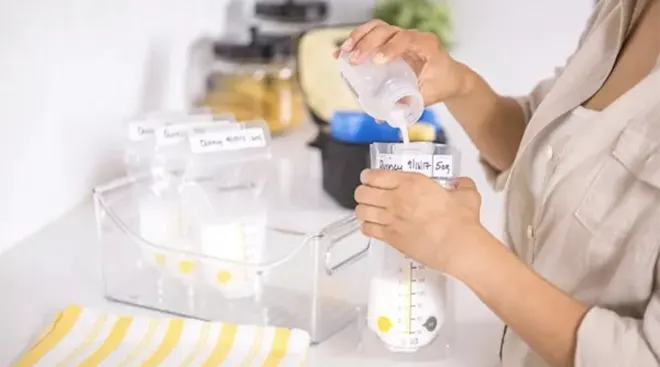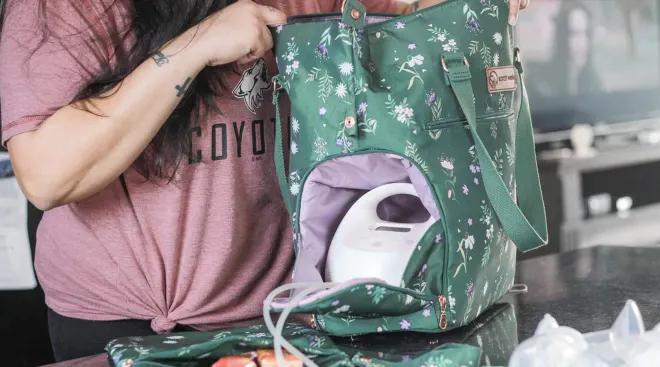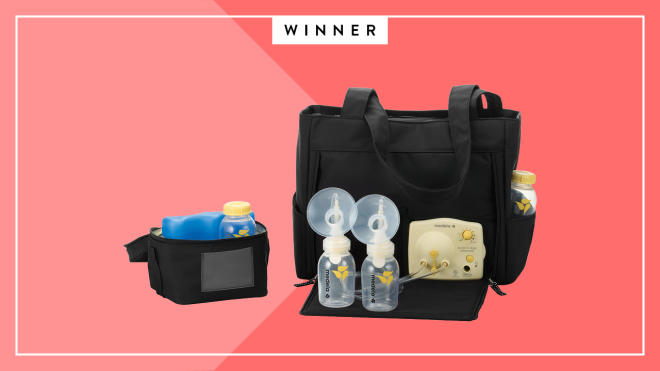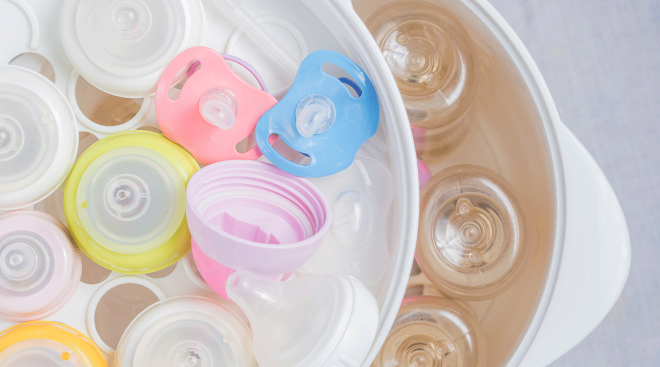How to Choose the Best Breast Pump for Your Needs, According to Experts
As a mom of two who has spent the past two years testing dozens of breast pumps for The Bump, I know how overwhelming it can be to choose the right one for your needs. Whether you’re a first-time mama or a seasoned one, the vast array of options can make the decision feel daunting. But here’s the thing: finding the right breast pump is deeply personal and depends on several factors—like your lifestyle, goals, and feeding preferences.
“One of the biggest challenges for moms is that they haven’t even narrowed down what they want infant feeding to look like for their family,” says Jessica Anderson, IBCLC, virtual lactation consultant and owner of Genuine Lactation. “Until we know what it is that you are trying to accomplish and what your family situation is, it’s really hard to recommend a specific medical device.” Allison Tolman, IBCLC, owner and lead breast pump expert and coach at New Little Life concurs, telling us that when she’s asked about the best breast pump, “my response to that is always—for what? What are you looking for? What’s important to you?”
This article is about the different types of breast pumps available to nursing moms, and the pros and cons of each for different feeding plans and circumstances. If you’re looking for more information on a specific type of breast pump, check out our dedicated articles on electric breast pumps, wearable and hands-free breast pumps and manual breast pumps.
- I, along with other nursing moms, put dozens of breast pumps through rigorous product testing within each pump category: electric, wearable, hands-free and manual. We evaluated each pump according to a set list of criteria, including ease of use, effectiveness, comfort, quality, value, and style and design. We shared our testing results with The Bump editorial team, and from there, we selected the best overall options for each pump category. The choices below on those overall best selections.
- We interviewed two IBCLCs (International Board Certified Lactation Consultants) to gain insight into the unique features of various breast pumps available to moms, along with the essential considerations to keep in mind when shopping for one. We delved deeply into how a mom’s lifestyle plays a crucial role in selecting the right pump.
- To see how each category of breast pump worked for a variety of women, we conducted exhaustive market research, scouring forums and message boards and reading user reviews to find out what parents across the country looked for in a breast pump according to their lifestyle.
Editorial integrity is at the heart of everything we publish. Read about how The Bump develops and reviews all articles, including product reviews.
Electric breast pumps
Every breast pump is a medical device used by breastfeeding mothers to extract milk from their breasts by generating suction that mimics a baby’s natural sucking pattern. Electric breast pumps (or tabletop breast pumps) generate this suction by using a powerful motor, powered by an outlet or battery. These pumps are typically faster and more efficient than other versions—as Tolman says, “electric pumps tend to be the most reliable and produce the most consistent results.” However, the large motor that makes electric pumps so reliable also makes them the least portable option, tying you to one spot while you pump (especially if your model is outlet-powered). Electric pumps are the ideal choice for frequent use, perfect for moms who need to pump regularly. A bigger motor might mean the pump is bulkier, but it tends to produce better and quicker results, and last longer than pumps with smaller motors.
When choosing an electric breast pump, Tolman notes that they’re not all created equal. “Tabletop pumps vary widely [in terms of] both the suction capabilities, cycle speeds, programming of the pump, flange kit that it comes with, and suction patterns. There are a lot of different things that go into what a pump does. A common misconception is that it’s all about suction, she explains. But more suction is not a better thing. “There’s so much more to how a pump functions,” Tolman says. Understanding the full range of features and settings available can help mothers select the right pump for their needs, whether for single or double pumping.
Pros:
- Efficient Many moms report they can express more milk in less time. Electric pumps are particularly helpful for mothers who need to pump frequently or for long durations.
- Capable of double pumping. Most electric pumps offer double pumping, allowing the expression of milk from both breasts simultaneously.
- Consistent. Electric pumps often produce more consistent suction, which can be important for moms trying to maintain or increase their supply.
- Customizable. Adjustable suction strength and speed allow moms to find the most comfortable and effective setting for them.
Cons:
- Bulky. They can be larger and bulkier than other pumps, making them less convenient for on-the-go use.
- Power-dependent. Since electric pumps require a power source (batteries or an electrical outlet), they may not be as convenient in situations where power is unavailable or limited.
- Noisy. Some electric pumps can be noisy, which may be disruptive, especially if privacy or a quiet environment is important.
Wearable breast pumps
A wearable breast pump is a compact, self-contained device designed to fit discreetly inside a bra, allowing for pumping without the need to hold the device in place. Tolman defines a wearable as "a pump where the milk collection device and the motor can both fit inside the bra.” Anderson notes, “If the entire unit is contained within your bra, you are as least restricted by pumping that you could possibly be.”
However, the smaller motor can come at the cost of some efficiency and longevity. Wearable pumps are best suited for moms who need flexibility in their routines—the main benefit they offer is portability and convenience. “One of my favorite uses for a wearable pump is if a mom is struggling to keep up her pumping schedule. A wearable pump can be a nice supplement to help fill in the gaps,” says Tolman. These pumps often have a dual-motor system, offering higher suction, though suction varies by model.
Pros:
- Discreet. “A wearable pump can work really well for moms who need something discreet,” says Tolman. The compact design allows for more privacy and freedom, making it easier to pump while on the go.
- Convenient. Since the wearable pump fits discreetly inside a bra, it frees up the user’s hands and body, offering comfort and flexibility to go about their day without being restricted by tubes or cords.
- Enables multitasking. Even more than hands-free breast pumps, wearable pumps allow moms to pump while doing other activities, whether at work, at home, or while running errands, without the need to be tethered to a traditional pump setup.
- Portable. These pumps are compact and easy to transport, making them ideal for moms who are frequently on the move or need to pump outside the home. They’re an excellent choice for traveling or when working in different environments.
Cons:
- Less efficient. “Wearable pumps often tend to be less efficient than a traditional pump,” says Tolman. They may not offer the same level of suction or milk output as larger, traditional pumps. “Wearables are always going to provide less efficiency just because of the nature of the compression of the breast tissue,” says Anderson.
- Creates challenges with flange sizing. Finding the right fit for a wearable pump may be trickier since the pump is hidden inside the bra, making adjustments more difficult. “Flange sizing is more challenging because you can’t see anything,” says Tolman.
- Creates less focus during sessions. “The way that a wearable pump is designed to be used, moms are paying less attention to what’s happening during a session,” notes Tolman. This lack of focus may reduce efficiency since there’s less intentional engagement with the process.
- Less durable. It’s not uncommon for wearable pumps to wear out before a year of consistent use. “The tiny motor only goes so far,” says Tolman, meaning the pumps may lose efficiency or break down faster than electric pumps.
Hands-free breast pumps
A hands-free breast pump is almost like a midpoint between wearable and electric pumps. They’re smaller and more portable than an electric breast pump, and designed to work with a pumping bra so moms can pump without having to hold the device in place. As Anderson points out, this design allows mothers to perform other tasks while pumping “versus holding the flanges to the body,” providing more freedom and convenience. This setup makes hands-free breast pumps well-suited to moms who multitask during pumping sessions.
The term “hands-free” can be a bit misleading—these designs aren’t quite as portable as wearable pumps, as hands-free breast pumps typically have an external motor, connected by tubing, instead of an all-in-one design. The larger, external motor typically offers more power than a wearable pump, but the tubing can get in the way. Hands-free pumps offer much of the efficiency of an electric pump without tying you to one task, but depending on the design you may not be easily running around the house or office while pumping as you could with a wearable.
Pros:
- Portable. Hands-free pumps are typically more portable and easy to move around than electric breast pumps.
- Enables multitasking. You can perform other activities without having to hold the flanges in place.
- Traditional flange design. These pumps often use traditional flanges, offering some of the effectiveness of a standard pump with the added benefit of being more mobile.
Cons:
- Tubing can be cumbersome. “Tubing can be annoying and cumbersome,” says Anderson. The extra parts needed for the pump to function can get in the way, especially if you’re moving around a lot, making it less convenient than a truly portable, wearable pump.
- External motor. Since the motor is external, it can still be bulkier and heavier than wearable pumps. This may limit some mobility, especially if you need to be discreet or move around a lot.
- Longer setup time. Unlike wearable pumps, which are self-contained and easy to use with minimal setup, hands-free pumps may require more time to get everything in place (like attaching flanges and tubing, and securing the pump to a bra).
- Not completely hands-free. While they allow for some hands-free use, you still need to attach and adjust the pump properly. This can be more involved than a wearable pump, which fits directly inside a bra with minimal adjustment.
Manual breast pumps
A manual breast pump is a type of breast pump that requires the user to physically operate it by squeezing a handle or lever to create suction and express milk. Unlike motor-powered pumps, which do the work automatically, manual pumps require continuous effort from the user throughout the pumping session. “Most people actually can pump just as well with a manual pump as they can with an electric pump,” explains Anderson. “The difference is the amount of work they have to put into it.”
Manual pumps are often recommended as a backup option, especially during the early days of breastfeeding, as they can be useful for quick, short pumping sessions. “Manual pumps can be really nice for the early days, trying to get a quick session in. I always recommend one as a backup,” says Tolman. Many mothers find manual pumps to be intuitive and easy to use, allowing them to pump faster. It also offers a hands-on approach that helps moms familiarize themselves with their breasts and milk production.
Pros:
- Affordable. Manual breast pumps are typically more affordable than electric or wearable ones, making them a cost-effective option for mothers who need a simple, basic pump.
- Portable and compact. They are lightweight, small, and easy to transport, making them ideal for moms who need a portable option or are traveling.
- Doesn’t require power. Manual pumps don’t require electricity or batteries, so they can be used anywhere, making them great for on-the-go use or when power is unavailable.
- Offers better control. When you’re providing the suction power instead of an electric motor, you decide on the speed and power.
- Intuitive to use. Many mothers find manual pumps to be easier to operate. “A lot of times, moms can pump faster because it’s intuitive to use,” says Anderson, making them a good option for those who want a quick, hands-on experience.
- Helps mothers learn about their bodies. Using a manual pump allows mothers to become more familiar with their breasts and milk flow, making it “a really good way for a mom to know her breasts,” according to Tolman.
Cons:
- Requires more effort. Unlike electric pumps, manual pumps require the user to continuously squeeze the handle or lever, which can be tiring and time-consuming, especially during longer sessions. “The entire time you’re using a manual pump, you have to be doing the work,” says Anderson.
- Single pump operation. While moms can typically empty their breasts in 5-10 minutes with a manual pump, they can only pump one breast at a time.
- Limited features. Manual pumps tend to have fewer features and adjustable settings than electric pumps, which may limit their flexibility or efficiency.
- Difficult to be discreet. Using a manual pump can be challenging when it comes to discretion. Since the user needs to squeeze the handle or lever to create suction, it can be difficult to pump discreetly in public or during situations where mom needs privacy.
When it comes to choosing the right breast pump, both experts emphasize that there is no one-size-fits-all solution. The best pump type depends on an individual’s specific situation, goals, and needs. “It gets dangerous when we start lumping large groups together,” says Tolman, stressing that a personalized approach is key. “It really matters to me what the mom’s goals are and what those barriers are, and that’s how you find the right pump for her,” Tolman adds. Each mom’s circumstances—from work schedule to feeding plan—can greatly impact the best choice of pump.
Tolman offers a specific example of an ER doctor: If she were to recommend an electric pump alone to such a mom, the odds that she would meet her goal of pumping two to three times a day would be low—a busy doctor is unlikely to be able to sit and plug in for pumping sessions. This is an instance where Tolman would likely recommend using a wearable option to ensure session consistency. “It’s better to have more frequent, potentially less effective sessions than to be skipping sessions because the pump you have is creating too many barriers to get you sitting down,” says Tolman. In some cases, the tradeoff of using a wearable pump—which might not be as powerful as a traditional pump—may be worth it for its convenience and flexibility. This approach can allow moms to pump more regularly, even if each session is shorter or less efficient, rather than skipping sessions altogether due to logistical difficulties.
A high-efficiency electric pump with adjustable settings and high suction power is the best choice for exclusive pumpers. These pumps are designed for frequent use and can help maximize milk output, which is especially important for exclusive pumpers.
Additionally, a wearable breast pump can be a game changer for moms who need portability and convenience. Wearable pumps allow mothers to pump while multitasking, making them ideal for moms on the go. However, as Anderson and Tolman both point out, the best choice depends on the mom’s specific needs and goals—whether it’s convenience, speed, comfort, or suction power.
Ultimately, the right pump depends on each mom’s unique needs. Whether you’re pumping at work, exclusively pumping, or simply looking for a quick and portable solution, various pump types suit different lifestyles. The key is identifying your goals and choosing a pump that best supports them.
Finding the right flange size
“Getting a well-fitting flange is essential for long-term milk production,” says Tolman, crucial for both comfort and efficiency. “A mom in a good size will be able to well empty the breast comfortably during a session in a reasonable amount of time.”
The flange is the part of the pump that surrounds the nipple, and a poor fit can lead to various issues, such as incomplete milk removal, discomfort, and even potential nipple damage. Tolman emphasizes that having the right size can help a mom empty the breast efficiently, which is key for maintaining milk supply and ensuring that each pumping session is productive.
“When you have an appropriate flange size, you increase comfort, you can increase efficiency (also the amount of milk you get out and the speed at which you get it out), and you also reduce the risk of tissue damage,” says Tolman. A good fit can result in a faster, more efficient pumping session, which is especially important for busy moms who need to pump frequently.
Anderson further explains, “We don’t want to put the nipple under undue stress in a flange that’s too big or too small.” This is where many moms can run into trouble. A flange that’s too small can cause compression, resulting in pain, bruising, or reduced milk output, while a flange that’s too large can lead to ineffective suction and also cause discomfort. “The way I describe it the most is that it almost fits like skinny jeans,” says Anderson. "Everything should fit that nicely, but just like you wouldn’t want to cram yourself into skinny jeans, we don’t want you to cram yourself into a flange that’s too small.” It’s clear that finding the right fit is about more than just size; it’s about ensuring that the flange is comfortably snug around the nipple without applying unnecessary pressure. And just like finding the right pair of jeans, it might take a little trial and error.
In the past, breast pump companies would recommend that moms measure their nipple size and then add a few millimeters to determine the correct flange size. “It’s really more complex than that,” says Tolman. The idea that flange size can be determined purely by measurement is outdated and too simplistic. Tolman explains that factors such as the elasticity of the nipple tissue and how it responds to suction play an essential role in determining the right fit. “Is it inelastic? Is it really elastic? Nipples come in all different shapes and sizes,” says Tolman, reinforcing the idea that a one-size-fits-all approach simply doesn’t work.
Additionally, nipple size can change throughout a breastfeeding journey, so the flange size may need to be adjusted over time. “Even if you’re sized in the hospital, two weeks later, it could be drastically different.” Changes in nipple size typically occur at various stages of the breastfeeding experience, such as around six weeks, three months, six months, and twelve months. As Tolman suggests, it’s essential to check in with a lactation consultant at these times to reassess the flange size and ensure it remains the right fit.
By understanding the significance of flange size and how it can change over time, moms can prevent discomfort or ineffective output issues, ultimately improving their milk supply and overall pumping experience.
Overall best electric breast pump
The Pumpables SuperGenie is a powerful breast pump designed for moms who need flexibility and comfort. With a strong suction level of 330 mmHg, it offers quick, effective pumping efficiency. Featuring 16 speeds and 16 suction levels, as well as a letdown mode with nine speeds and nine suction levels, it provides complete control over mom’s pumping experience. The SuperGenie offers 2.5 hours of battery life and a fold-down handle, with a nightlight that adds convenience for nighttime use.
The Liquid Shield Kit (sold separately) provides a perfect flange fit, with soft silicone that "conforms to the body slightly," says Anderson. “I love the Pumpables liquid flanges. They’re super comfortable and often the answer for someone who needs to pump eight times a day and is tired of pumping on hard plastic.” This added comfort is a game-changer for moms who pump frequently.
To find out more, read our full review of the Pumpables SuperGenie Breast Pump.
Overall best wearable breast pump
The Lansinoh Discreet Duo is a compact and efficient double electric breast pump designed to fit seamlessly into busy moms' lives. Its portable, discreet design allows you to pump while going about your daily activities. As Anderson explains, “The main advantage of wearable pumps is that you can pump while going about your daily life. It is the least disruptive means of pumping milk that we have available to us today.”
This pump features nine levels of suction and four pumping modes, delivering a powerful suction strength of up to 260 mmHg to maximize milk expression. It includes leak-resistant six-ounce reusable breastmilk collection cups and comes with two flange sizes (21 mm and 24 mm). The LED display screen ensures easy reading, even during nighttime feeds.
The Discreet Duo offers customizable suction levels and speed settings for a personalized, comfortable pumping experience. Its quiet operation ensures discretion, making it ideal for moms who need to pump in public or at work.
To find out more, read our full review of the Lansinoh Discreet Duo.
Overall best hands-free breast pump
The Elvie Stride Plus is a hands-free breast pump designed for moms seeking powerful performance combined with convenience. With suction up to 280 mmHg and customizable suction and speed settings, this pump ensures effective milk expression with ease. The Elvie Stride Plus allows you to pump discreetly with its ultra-quiet noise-reduction technology; this quiet operation ensures you can pump discreetly at work without drawing attention.
Designed with comfort in mind, it includes breast shields in sizes 21 mm and 24 mm, with additional sizing options available. The Elvie Stride Plus also features a real-time tracking app, allowing you to monitor your sessions and stay on top of your pumping routine. With a battery life of up to three hours, a portable design, and easy-to-clean components, the Elvie Stride Plus is a top choice for moms who need efficiency and flexibility in their pumping routine.
To find out more, read our full review of the Elvie Stride Plus.
Overall best manual breast pump
As recommended by experts like Tolman, manual pumps are perfect for quick sessions and portable use. The Lansinoh Manual Breast Pump offers a simple, efficient solution for moms seeking occasional pumping or a reliable backup. This pump features flanges in 25 mm and 30.5 mm sizes, while the easy-express handle design reduces hand fatigue, allowing for a more comfortable pumping experience.
With few parts, this pump is easy to clean and assemble, and the wide-neck bottles are compatible across the Lansinoh range, so you can use the same bottle to pump, store and feed.
To find out more, read our full review of the Lansinoh Manual Breast Pump.
About the writer:
Christine Carpenter is a New York-based storyteller and a devoted mom of two young boys. With firsthand experience testing and using a wide range of breast pumps, she understands the challenges that moms face in finding the right pump for their unique needs. Drawing on her expertise in product development, Christine offers insightful, well-informed advice to help moms make the best choices for their breastfeeding journey.
Please note: The Bump and the materials and information it contains are not intended to, and do not constitute, medical or other health advice or diagnosis and should not be used as such. You should always consult with a qualified physician or health professional about your specific circumstances.
Plus, more from The Bump:
Stacey Fink, BSN, RN, IBCLC, is a board-certified lactation consultant, registered nurse and owner of Lactation Express based in New Jersey.
The Bump May 2023 Survey. Editors conducted a survey of 300 new parents from among The Bump community, and asked what breast pumps they used and what they liked and disliked about them.
Navigate forward to interact with the calendar and select a date. Press the question mark key to get the keyboard shortcuts for changing dates.







































